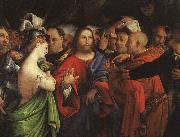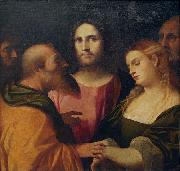
Oil On
Canvas, Real Flavor of Old Masters
|
Lorenzo Lotto
|
|||
|
|
|||
| Italian 1480-1556 Lorenzo Lotto Galleries In this last period of his life, Lorenzo Lotto would frequently move from town to town, searching for patrons and commissions. In 1532 he went to Treviso. Next he spent about seven years in the Marches (Ancona, Macerata en Jesi), returning to Venice in 1540. He moved again to Treviso in 1542 and back to Venice in 1545. Finally he went back to Ancona in 1549. This was a productive period in his life, during which he painted several altarpieces and portraits : Santa Lucia before the Judge, 1532, Jesi, Pinacoteca comunale The Sleeping Child Jesus with the Madonna, St. Joseph and St. Catherine of Alexandria, 1533, Bergamo, Accademia Carrara Portrait of a Lady as Lucretia, 1533, National Gallery, London. Holy Family with SS Jerome, Anna and Joachim, 1534, Firenze, Uffizi Holy Family, ca 1537, Paris, Louvre Portrait of a Young Man, Firenze, Uffizi Crucifixion, Monte San Giusto, Church of S Maria in Telusiano Rosary Madonna, 1539, Cingoli, Church of San Nicolo Portrait of a Man, 1541, Ottawa, National Gallery of Canada Bust of a Bearded Man, 1541, ascribed, San Francisco, Fine Arts Museum The Alms of Saint Anthony, 1542, Venezia, church SS Giovanni e Paolo Madonna and four Saints, 1546, Venezia, Church of San Giacomo dell??Orio Portrait of fra?? Gregorio Belo da Vicenza, 1548,New York, Metropolitan Museum Assumption, 1550, Ancona, church San Francesco alle Scale The Crossbowman, 1551, Rome, Pinacoteca Capitolina Portrait of an Old man, ascribed, ca 1552, Saint Petersburg, Ermitage Presentation in the Temple, 1555, Loreto, Palazzo Apostolico A Venetian woman in the guise of Lucretia (1533).At the end of his life it was becoming increasingly difficult for him to earn a living. Furthermore, in 1550 one of his works had an unsuccessful auction in Ancona. As recorded in his personal account book, this deeply disillusioned him. As he had always been a deeply religious man, he entered in 1552 the Holy Sanctuary at Loreto, becoming a lay brother. During that time he decorated the basilica of S Maria and painted a Presentation in the Temple for the Palazzo Apostolico in Loreto. He died in 1556 and was buried, at his request, in a Dominican habit. Giorgio Vasari included Lotto's biography in the third volume of his book Vite. Lorenzo Lotto himself left many letters and a detailed notebook (Libro di spese diverse, 1538-1556), giving a certain insight in his life and work. Among the many painters he influenced are likely Giovanni Busi | |||
|
|
|||
|
|
Christ and the Adulteress Lorenzo Lotto4.jpg Painting ID:: 2598 Visit European Gallery |
1530-35 Musee du Louvre, Paris | |
Height Width |
INS/CM |
||
|
X |
|
||
|
|
|||
|
Palma il Vecchio
|
|||
|
|
|||
| (c. 1480 - July 1528), born Jacopo Palma or known as Jacopo Negretti, was an Italian painter of the Venetian school born at Serina Alta near Bergamo. He is called Palma Vecchio in English ("Old Palma" - in Italian Palma il Vecchio) to distinguish him from Palma Giovane, his great-nephew. When Palma arrived in Venice early in the 16th century, he reputedly was a companion and competitor of Lorenzo Lotto, and to some extent a pupil of Titian. He may also have taught Bonifazio Pitati and influenced Giovanni Busi. Palma's earlier works betray the influence of the Bellini. | |||
|
|
|||
|
|
Christ and the Adulteress new24/Palma il Vecchio-997356.jpg Painting ID:: 80733 Visit European Gallery |
Date ca. 1525-1528 Medium Oil on canvas cjr | |
Height Width |
INS/CM |
||
|
X |
|
||
|
|
|||
|
Palma il Vecchio
|
|||
|
|
|||
| (c. 1480 - July 1528), born Jacopo Palma or known as Jacopo Negretti, was an Italian painter of the Venetian school born at Serina Alta near Bergamo. He is called Palma Vecchio in English ("Old Palma" - in Italian Palma il Vecchio) to distinguish him from Palma Giovane, his great-nephew. When Palma arrived in Venice early in the 16th century, he reputedly was a companion and competitor of Lorenzo Lotto, and to some extent a pupil of Titian. He may also have taught Bonifazio Pitati and influenced Giovanni Busi. Palma's earlier works betray the influence of the Bellini. | |||
|
|
|||
|
|
Christ and the Adulteress new25/Palma il Vecchio-849586.jpg Painting ID:: 84918 Visit European Gallery |
1525-1528 Medium Oil on canvas cyf | |
Height Width |
INS/CM |
||
|
X |
|
||
|
|
|||
|
Garofalo
|
|||
|
|
|||
| 1481-1559 Italian Garofalo Gallery Italian painter. Active mainly in Ferrara and the district around the Po delta, he was one of the most outstanding figures in Emilian classicism during the first half of the 16th century. In 1497 Garofalo father paid Boccaccio Boccaccino to teach his son the rudiments of painting. Garofalo first works were directly influenced by the Cremonese painter, to whom they were formerly even attributed. They consist of a series of small paintings depicting the Virgin and Child. The example in the Ca d Oro in Venice must have been Garofalo first painting and reveals not only the lessons learned from Boccaccino, but also signs of the influence of Domenico Panetti (c. 1460-before 1513), traditionally recorded as his first master. Another Virgin and Child (Assisi, Perkins priv. col.) shows signs of the early influence of Lorenzo Costa the elder, while the example in the Nationalmuseum, Copenhagen, shows a similarity with the early works of his contemporary, Lodovico Mazzolino. A particularly important project in Ferrara during the earliest years of the 16th century, involving numerous highly skilled artists, was the fresco decoration of the oratory of the Concezione. The frescoes (Ferrara, Pin. N.) represent a significant development in the city art. Garofalo hand has been identified in the Presentation in the Temple, in which he reveals a familiarity not only with local art, but also with the high points of Bolognese classicism, whose greatest exponents were Francesco Francia and Lorenzo Costa the elder. Around 1505, Garofalo works show a close familiarity with artistic developments in Bologna, in particular the mature style of Costa and the decoration in 1505-6, by Francesco Francia, Costa, Aspertini and others, of the oratory of S Cecilia in S Giacomo Maggiore. Garofalo Virgin Enthroned between SS Martin and Rosalia (Florence, Uffizi), created for Codigoro Cathedral, should be seen within this context, whereas the small altarpiece for the Arcivescovado, Ferrara, although executed at the same time, shows early, if faint, signs of the influence of Venetian painting of the period. | |||
|
|
|||
|
|
Christ and the Adulteress new25/Garofalo-966836.jpg Painting ID:: 92557 Visit European Gallery |
Oil on panel, 55 x 44 cm TTD | |
Height Width |
INS/CM |
||
|
X |
|
||
|
|
|||










